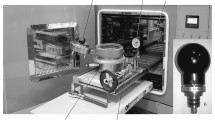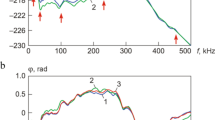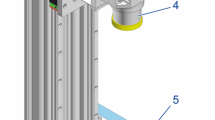We present information about a standard installation used for the calibration of hydrophones at frequencies of 0.1–3.0 MHz. The installation is created with an aim to extend the frequency range of the GET 55-2017 State Primary Standard to the region of high-frequency ultrasound. The necessity of development of this installation is justified. We briefly consider basic principles of its operation and the possibilities of measurements. The requirements to the characteristics of ultrasonic transducers are discussed. In the choice of standard transducers, we give priority to their time stability because, in the course of transmission of the unit with the help of a tone signal, the uniformity of the frequency characteristic of sensitivity of the transducer is not of primary importance. To reduce the influence of directivity, we use a precise four-coordinate system of positioning of the transducers, which includes the possibility of control of their mutual positions with the help of a laser beam. We also consider the problems connected with the possibility of passing to higher frequencies.



Similar content being viewed by others

References
V. N. Lekomtsev A. V. Torgunako, D. V. Titarenko, and V. K. Smirnov, “Technology of production of 3D sound-imaging devices intended for the survey of vertical walls in turbid water with the use of electron-mechanical scanning at a distance up to 100 m,” Sovr. Tend. Razv. Nauki Tehnol., No. 3–3, 72–76 (2017).
V. N. Lekomtsev and D. V. Titarenko, “Contemporary units of the underwater sound-imaging equipment,” Sovr. Tekhnol. Avtomatiz. (2011), https://www.cta.ru/cms/f/441553.pdf, acc. 12.19.2019.
A. E. Isaev and A. N. Matveev, “Calibration of hydrophones in a fi eld with continuous radiation in a reverberating pool,” Akust. Zh., 55, No. 6, 727–73 (2009).
S. Р. Robinson, J. Acoust. Soc. Amer., 120, No. 3, 1366–1373 (2006), DOI: https://doi.org/10.1121/1.2228790.
A. Malarkodi, G. Latha, M. A. Atmanand, et al., “Interlaboratory comparisons of hydrophone calibration in the 3–500 kHz frequency range,” Izmer. Tekhn., No. 1, 69–72 (2016).
A. E. Isaev, A. N. Matveev, A. M. Polikarpov, and N. G. Shcherblyuk, “Measurement of the sensitivity phase-frequency responses of hydrophones by the reciprocity method,” Izmer. Tekhn., No. 6, 56–59 (2013).
N. G. Shcherblyuk, “Modernization of the GET 55-2011 standard installation; phase calibration of hydrophones,” Tekhn. Probl. Osv. Mir. Okeana, 6, 246–250 (2015).
G. Hayman and S. Robinson, Proc. 11th Europ. Conf. on Underwater Acoustics, Edinburgh (2012), pp. 1437–1444.
Ultrasound Hydrophone Calibration, https://www.npl.co.uk/products-services/ultrasound/hydrophonecalibration, acc. 12.19.2019.
E. G. Radulescu, P. A. Lewin, J. Wójcik, and A. Nowicki, Ultrasonics, 41, No. 4, 247–254 (2003), DOI: https://doi.org/10.1016/S0041-624X(03)00123-9.
Author information
Authors and Affiliations
Corresponding author
Additional information
Translated from Izmeritel’naya Tekhnika, No. 6, pp. 61–65, June, 2020.
Rights and permissions
About this article
Cite this article
Isaev, А.Е., Polikarpov, А.М., Sil’vestrov, S.V. et al. Standard Installation for the Transmission of Units of Sound Pressure in the Ultrasonic Frequency Range. Meas Tech 63, 487–492 (2020). https://doi.org/10.1007/s11018-020-01813-0
Received:
Accepted:
Published:
Issue Date:
DOI: https://doi.org/10.1007/s11018-020-01813-0



